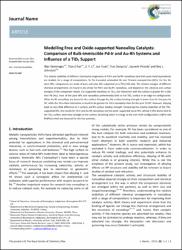| dc.contributor.author | Demiroğlu, İlker | |
| dc.contributor.author | Fan, Tian-E. | |
| dc.contributor.author | Li, Z. Y. | |
| dc.contributor.author | Yuan, Jun | |
| dc.contributor.author | Liu, Tun-Dong | |
| dc.contributor.author | Piccolo, Laurent | |
| dc.contributor.author | Johnston, Roy L. | |
| dc.date.accessioned | 2019-10-21T21:12:26Z | |
| dc.date.available | 2019-10-21T21:12:26Z | |
| dc.date.issued | 2018 | |
| dc.identifier.issn | 1359-6640 | |
| dc.identifier.issn | 1364-5498 | |
| dc.identifier.uri | https://dx.doi.org/10.1039/c7fd00213k | |
| dc.identifier.uri | https://hdl.handle.net/11421/21371 | |
| dc.description | WOS: 000444554700003 | en_US |
| dc.description | PubMed ID: 29796531 | en_US |
| dc.description.abstract | The relative stabilities of different chemical arrangements of Pd-Ir and Au-Rh nanoalloys (and their pure metal equivalents) are studied, for a range of compositions, for fcc truncated octahedral 38- and 79-atom nanoparticles (NPs). For the 38-atom NPs, comparisons are made of pure and alloy NPs supported on a TiO2(110) slab. The relative energies of different chemical arrangements are found to be similar for Pd-Ir and Au-Rh nanoalloys, and depend on the cohesive and surface energies of the component metals. For supported nanoalloys on TiO2, the interaction with the surface is greater for Ir (Rh) than Pd (Au): most of the pure NPs and nanoalloys preferentially bind to the TiO2 surface in an edge-on configuration. When Au-Rh nanoalloys are bound to the surface through Au, the surface binding strength is lower than for the pure Au NP, while the Pd-surface interaction is found to be greater for Pd-Ir nanoalloys than for the pure Pd NP. However, alloying leads to very little difference in Ir-surface and Rh-surface binding strength. Comparing the relative stabilities of the TiO2-supported NPs, the results for Pd-Ir and Au-Rh nanoalloys are the same: supported Janus NPs, whose Ir (Rh) atoms bind to the TiO2 surface, bind most strongly to the surface, becoming closer in energy to the core-shell configurations (Ir@Pd and Rh@Au) which are favoured for the free particles. | en_US |
| dc.description.sponsorship | Xiamen University; EPSRC Critical Mass Grant TOUCAN [EP/J010804/1]; EPSRC [EP/L000202]; TOUCAN grant; Royal Society International Exchange Grant [IE140712] | en_US |
| dc.description.sponsorship | T-EF is grateful for funding from the Graduate School of Xiamen University. RLJ and ID acknowledge support through EPSRC Critical Mass Grant (EP/J010804/1) TOUCAN. Calculations were performed on the following HPC facilities: The University of Birmingham Bluebear HPC facility (see http://www.bear.bham.ac.uk/bluebear for more details) and the UK's national HPC facility, ARCHER, both via membership of the UK's HPC Materials Chemistry Consortium, which is funded by EPSRC (EP/L000202), and via the TOUCAN grant. ZYL acknowledges Royal Society International Exchange Grant IE140712. LP acknowledges the French METSA network and Corinne Ulhaq (IPCMS, Strasbourg) for STEM imaging of Pd-Ir nanoparticles. | en_US |
| dc.language.iso | eng | en_US |
| dc.publisher | Royal Soc Chemistry | en_US |
| dc.relation.isversionof | 10.1039/c7fd00213k | en_US |
| dc.rights | info:eu-repo/semantics/openAccess | en_US |
| dc.title | Modelling free and oxide-supported nanoalloy catalysts: comparison of bulk-immiscible Pd-Ir and Au-Rh systems and influence of a TiO2 support | en_US |
| dc.type | article | en_US |
| dc.relation.journal | Faraday Discussions | en_US |
| dc.contributor.department | Anadolu Üniversitesi, Mühendislik Fakültesi, Makine Mühendisliği Bölümü | en_US |
| dc.identifier.volume | 208 | en_US |
| dc.identifier.startpage | 53 | en_US |
| dc.identifier.endpage | 66 | en_US |
| dc.relation.publicationcategory | Makale - Uluslararası Hakemli Dergi - Kurum Öğretim Elemanı | en_US |


















